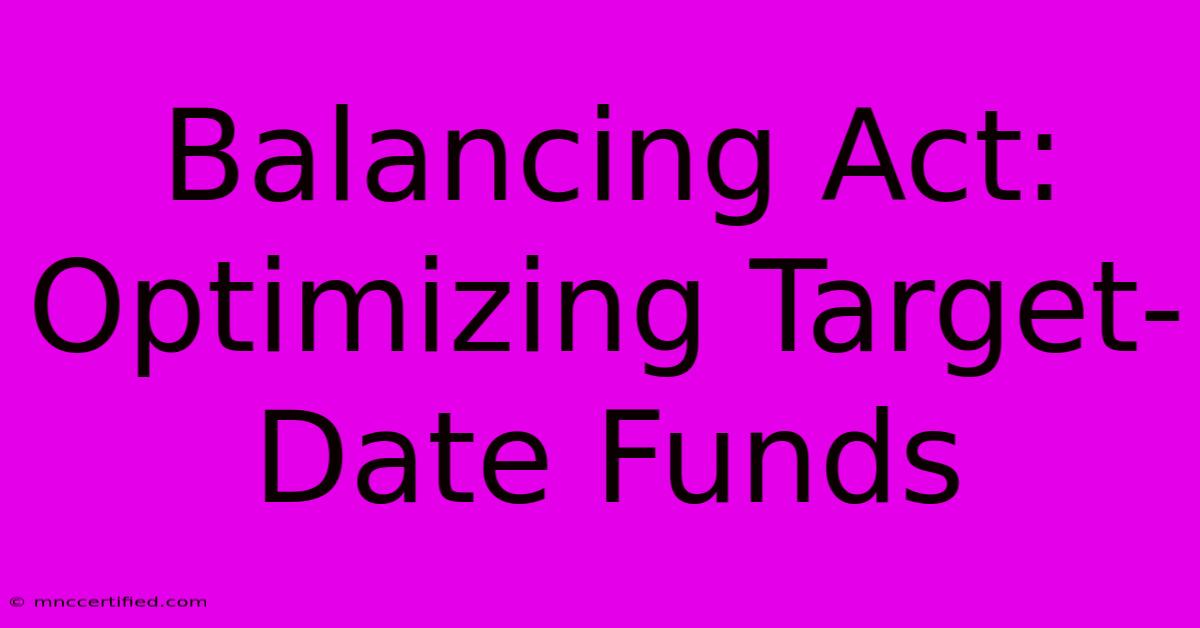Balancing Act: Optimizing Target-Date Funds

Table of Contents
Balancing Act: Optimizing Target-Date Funds for Retirement Success
Target-date funds (TDFs) have become incredibly popular for retirement savers, offering a seemingly simple solution: invest now and let the fund automatically adjust its asset allocation to become more conservative as your target retirement date approaches. But are TDFs truly a "set it and forget it" solution, or is there room for optimization to maximize your retirement savings? This article explores how to get the most out of your TDFs and achieve your retirement goals.
Understanding Target-Date Funds: The Basics
TDFs are mutual funds or exchange-traded funds (ETFs) designed to align with a specific retirement date. They typically invest in a mix of stocks and bonds, gradually shifting towards a more conservative allocation (higher bond percentage, lower stock percentage) as the target date nears. This lifecycle approach aims to balance risk and return, reducing volatility closer to retirement.
Key Advantages of TDFs:
- Simplicity: Requires minimal investor involvement in asset allocation.
- Diversification: Typically invests across various asset classes.
- Automatic Rebalancing: Maintains a target allocation over time.
However, there are also limitations:
- One-size-fits-all approach: May not perfectly align with individual risk tolerance, time horizon, or financial goals.
- Expense ratios: Can vary significantly between providers, impacting long-term returns.
- Lack of control: Limited ability to customize the investment strategy.
Optimizing Your Target-Date Fund Strategy
While TDFs offer convenience, optimizing your approach can significantly impact your retirement outcomes. Here are key strategies to consider:
1. Choosing the Right Target Date
Selecting the appropriate target date is crucial. Consider your planned retirement age, not just your current age. A fund with a target date too far in the future might expose you to unnecessary risk, while one too close may limit growth potential.
2. Assessing Your Risk Tolerance
TDFs offer a default level of risk, but your personal risk tolerance might differ. Are you comfortable with potentially higher volatility in exchange for potentially higher returns, or do you prefer a more conservative approach? Understanding your risk profile is essential to determine if a TDF aligns with your needs. Consider seeking professional financial advice if you are unsure.
3. Evaluating Expense Ratios
Expense ratios eat into your returns over time. Compare the expense ratios of different TDFs before investing. Even a small difference can significantly impact your long-term savings. Look for low-cost index funds or ETFs.
4. Considering Your Specific Circumstances
Factors like your current savings, income, and anticipated retirement expenses should influence your TDF choice. If you're behind on your savings goals, you may need to consider a more aggressive allocation, even with a closer target date, to catch up. Conversely, if you're ahead of schedule, you may opt for a more conservative approach.
5. Supplementing with Other Investments
TDFs can be part of a broader retirement plan. You could supplement your TDF investment with other assets based on your risk tolerance and financial goals. This might include individual stocks, bonds, or real estate, but always consider the potential implications on your overall portfolio diversification.
6. Regularly Review and Rebalance (if necessary)
While TDFs handle rebalancing automatically, it's crucial to periodically review your investment performance and overall financial plan. Life circumstances change; therefore, your investment strategy may need adjustments. Consider seeking advice from a financial advisor to ensure your plan stays aligned with your evolving needs.
Conclusion: Making TDFs Work for You
Target-date funds offer a valuable pathway to retirement savings, simplifying the investment process. However, understanding their limitations and actively optimizing your strategy – through careful selection, risk assessment, and regular review – can significantly enhance your chances of achieving your retirement goals. Remember that personalized financial advice can prove invaluable in tailoring your TDF strategy to your specific circumstances. Don't treat TDFs as a completely hands-off solution; engage with your investments and ensure they're continually working towards your long-term financial well-being.

Thank you for visiting our website wich cover about Balancing Act: Optimizing Target-Date Funds. We hope the information provided has been useful to you. Feel free to contact us if you have any questions or need further assistance. See you next time and dont miss to bookmark.
Featured Posts
-
Christmas Snow Pre Christmas Travel Wind Alert
Dec 20, 2024
-
Kakko Borgen Swap Rangers Kraken Trade
Dec 20, 2024
-
Watch Knicks Fans Cheer Towns
Dec 20, 2024
-
Big Lots Nationwide Going Out Of Business Sales
Dec 20, 2024
-
Driving Test Changes Announced
Dec 20, 2024